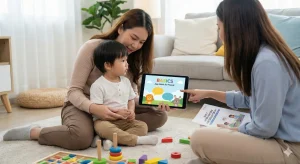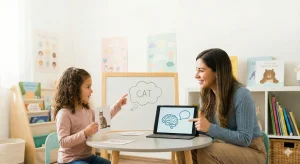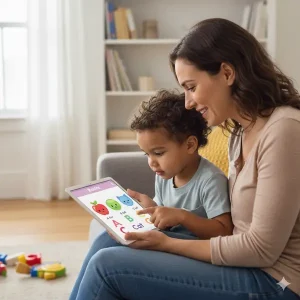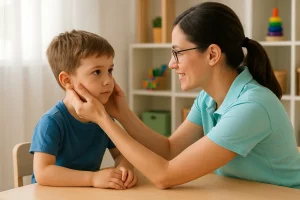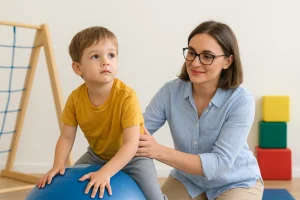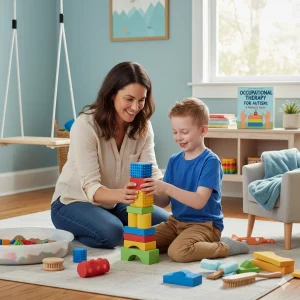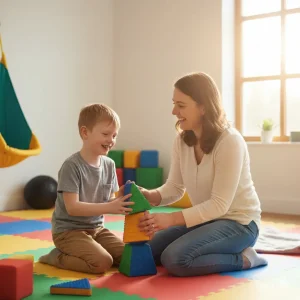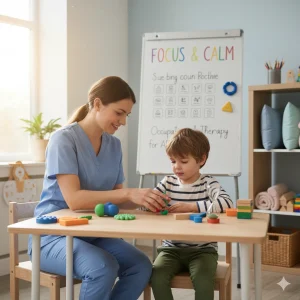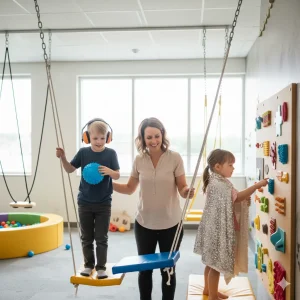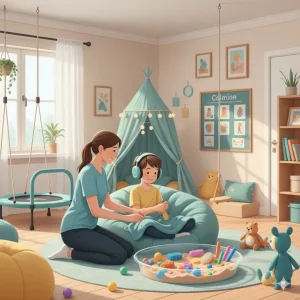3-Year-Old Milestones & Occupational Therapy Guide
By Wellness Hub
Last Updated: October 16, 2025
Watching your little one grow is full of magical moments — their first full sentence, their wobbly run across the room, or the way they start pretending to cook dinner in their toy kitchen. At 3 years old, your child is hitting some of the most important developmental milestones — from speech and language to motor and social-emotional skills. But what if your 3-year-old isn’t talking as much as other kids? What if they’re struggling with dressing, play skills, or sensory sensitivities?
Every child develops at their own pace, but understanding 3-year-old milestones can help you spot early signs of delays. This is where occupational therapy can make a real difference — supporting your child’s speech, fine motor, and sensory development through play-based, family-centered strategies. In this guide, we’ll break down key 3-year-old developmental milestones, early red flags to watch for, and how occupational therapy for toddlers can help your child thrive.
Understanding 3-Year-Old Developmental Milestones
As parents, it’s exciting to watch your child grow, learn, and explore their world. By the age of 3, children typically make big leaps in speech, motor skills, social-emotional development, and independence. These milestones give parents and professionals a clear picture of how a child is growing. But more importantly, they help identify when extra support—like occupational therapy—may be needed to guide development in the right direction.
Development doesn’t look the same for every child. Some may talk earlier, others may become more physically active first. But knowing what’s expected during this stage helps you spot delays early and act with confidence.
What Are Typical 3-Year-Old Milestones?
At this age, children are gaining confidence, independence, and new skills every day. A 3-year-old development checklist usually includes milestones across different areas: communication, fine motor, gross motor, social skills, and sensory development.
Here are some examples of what most 3-year-olds can do:
- Speech & Language
- Speak in short sentences (3–5 words)
- Follow simple instructions
- Ask “what” and “where” questions
- Name familiar objects and people
- Fine Motor Skills
- Hold crayons or pencils with better control
- String beads, build towers, and complete simple puzzles
- Begin using scissors with help
- Start dressing themselves (zippers, buttons, pulling up pants)
- Gross Motor Skills
- Climb stairs with alternating feet
- Run more smoothly and jump with both feet
- Pedal a tricycle
- Kick and throw a ball with control
- Social-Emotional Skills
- Play alongside or with other children
- Take turns with gentle guidance
- Show emotions clearly and begin understanding others’ feelings
- Engage in pretend play
- Sensory & Self-Regulation
- Enjoy sensory activities like sand or water play
- Tolerate different textures, sounds, and movements
- Begin to calm themselves with support
These milestones provide a foundation for preschool readiness, language learning, and social skills that shape the next few years of growth.
Why Tracking Milestones Matters for Early Intervention
Early identification is key. Developmental screening helps parents and professionals notice when a child may not be meeting age-appropriate skills. If your child isn’t meeting expected milestones, it doesn’t mean something is “wrong”—but it’s a sign to get support early rather than waiting.
Early intervention for 3-year-olds can make a big difference in:
- Strengthening language and communication
- Improving motor coordination
- Supporting sensory regulation
- Boosting attention and self-help skills
- Building confidence and independence
With the right support—like occupational therapy—many children can catch up, thrive, and enjoy learning through play.
Remember: Every child develops at their own pace, but tracking milestones gives you the power to act early if something seems off.
Speech and Language Milestones at Age 3
For parents, few moments feel as special as hearing your child express their thoughts, share a story, or ask endless “why” questions. Around age 3, children make tremendous progress in speech and language development—they begin to communicate their needs more clearly, understand conversations better, and express their personalities through words.
Tracking 3-year-old speech milestones helps parents know what to expect and when to get extra support. While every child develops at their own pace, understanding typical language skills at this age can guide you in encouraging healthy communication.
Also read: Occupational Therapy 18 Month Old: Simple Exercises to Boost Milestones
What a 3-Year-Old Should Be Able to Say and Understand
By age 3, most children are active little talkers. Their language starts to move beyond single words to meaningful conversations. You may notice them describing what they’re doing, asking simple questions, or repeating phrases they hear often.
Here are some typical speech and language milestones for 3-year-olds:
- Expressive Language (Speaking)
- Speak in 3–5 word sentences (e.g., “I want more juice”)
- Ask simple questions like “What’s that?” or “Where is it?”
- Use basic grammar (I, me, you, plurals)
- Name familiar people, toys, animals, and everyday objects
- Tell short stories or describe simple events
- Receptive Language (Understanding)
- Follow 2-step instructions (e.g., “Pick up the ball and give it to Daddy”)
- Understand familiar action words and everyday phrases
- Identify common objects and body parts when named
- Pay attention to short stories or songs
- Understand concepts like “in,” “on,” and “under”
By this age, strangers can usually understand most of what your child says, even if some words aren’t perfectly clear.
Red Flags in Speech Development
While all children grow at their own speed, some signs may suggest a speech delay or a need for extra support. Identifying these red flags early can make a big difference in your child’s communication journey.
Watch for these possible red flags at age 3:
- Not using short sentences by 3 years old
- Limited vocabulary or difficulty expressing needs
- Not following simple instructions or understanding everyday language
- Speech that is mostly unclear, even to familiar people
- Rarely asking questions or engaging in conversations
- Little to no interest in talking or playing with others
If your child shows some of these signs, it doesn’t mean something is “wrong” — it simply means they may benefit from additional support to reach their milestones.
Tip: When to Seek a Speech or Occupational Therapy Evaluation
Early intervention matters. If your child is not talking in short sentences, is difficult to understand, or seems frustrated while communicating, it’s a good idea to consult a speech-language pathologist or occupational therapist.
- Early therapy can help build strong communication foundations.
- A professional evaluation can uncover whether it’s a speech delay, articulation issue, or part of broader developmental needs.
- The earlier support begins, the easier it is to help your child thrive.
Parents often trust their instincts—if something feels “off,” seeking guidance can bring clarity and reassurance. A quick developmental screening can set your child on a positive path toward stronger communication and confidence.
Fine Motor Milestones for 3-Year-Olds
At age 3, your child’s hands and fingers are becoming more skilled, controlled, and curious. This is the stage when little hands love to build, color, stack, open, and explore — and these daily movements are essential for fine motor development.
Fine motor skills help children do important everyday activities like dressing, feeding themselves, holding a crayon correctly, and even preparing for writing. By understanding fine motor milestones at 3 years, parents can better support their child’s independence and confidence through simple, play-based activities.
What Fine Motor Skills Should a 3-Year-Old Have?
By age 3, your child’s hand strength, coordination, and control are growing rapidly. Their movements become more purposeful, and they begin to enjoy activities that require both focus and precision.
Here are some common fine motor milestones you can expect at this age:
- Crayon Grasp
- Begins to hold crayons or pencils with fingers instead of the whole hand.
- Scribbles and draws simple lines, shapes, and sometimes circles.
- Snipping with Scissors
- Learns to use child-safe scissors with adult guidance.
- Can make small snips on paper with growing hand control.
- Bead Stringing and Building
- Strings large beads or pasta pieces on a shoelace.
- Builds towers or simple structures with blocks.
- Feeding and Self-Care
- Uses a spoon or fork with minimal spills.
- Holds and drinks from an open cup with both hands.
- Dressing Skills
- Starts to zip and unzip with some help.
- Can pull on shirts, pants, and slip-on shoes independently.
These small daily achievements lay the foundation for pre-writing, drawing, self-feeding, and dressing independently — skills that build confidence and readiness for preschool.
Activities to Build Fine Motor Skills at Home
The best way to build fine motor skills is through play-based activities that are fun and easy to do at home. You don’t need expensive toys — everyday household materials can help strengthen those little hands.
Here are some OT-recommended activities parents can try:
- Scribble and Draw Together:
Use crayons, markers, or sidewalk chalk to make lines, shapes, or simple drawings. Encourage your child to trace circles or draw faces. - Cutting Practice with Child-Safe Scissors:
Let your child snip along bold lines on old magazines or colored paper with supervision. - Stringing and Sorting:
String beads, pasta, or buttons on yarn or pipe cleaners. Sorting objects by color or shape also builds finger coordination. - Playdough Fun:
Roll, squeeze, and pinch playdough to build hand strength. Add cookie cutters or toy tools to make it more engaging. - Clothespin and Sticker Play:
Let them clip clothespins to cardboard or peel stickers — both are excellent for hand–eye coordination. - Dress-Up Practice:
Encourage your child to pull on clothes, zip jackets, and practice simple fasteners like Velcro or snaps.
Small, consistent practice makes a big difference. These activities support hand strength, grip control, and independence — all essential for writing and self-help skills later on.
Gross Motor & Self-Care Skills at 3 Years
At 3 years old, your child is full of energy, curiosity, and movement. This is a big year for developing gross motor skills — the large muscle movements that help them run, jump, climb, and explore their world with growing independence. Alongside this, self-care skills start to blossom, setting the stage for confidence in daily routines like dressing, feeding, and using the toilet.
Understanding these gross motor milestones for 3-year-olds helps parents track progress and encourage healthy development through everyday play and practice.
Typical Gross Motor Milestones
Gross motor skills involve the big muscles of the legs, arms, and core. At this stage, your child’s movements become more controlled, balanced, and coordinated. They are no longer just exploring — they are mastering their physical abilities.
Here are some common physical milestones at age 3:
- Running with Better Coordination:
Your child can run more smoothly and stop without falling. They begin to enjoy chasing games and outdoor play. - Jumping with Two Feet:
Most 3-year-olds can jump forward, up, or off a small step. This shows growing leg strength and balance. - Climbing Stairs with Alternating Feet:
By this age, many children can go up and down the stairs, holding a railing, without needing to step with both feet on each stair. - Tricycle Pedaling:
Riding a tricycle or similar ride-on toy builds leg strength, coordination, and confidence. - Throwing and Kicking:
Your child can kick a ball with control and throw overhand, improving hand-eye coordination.
These skills lay the foundation for preschool activities, playground play, and early sports participation.
Self-Care Skills to Look For
Around age 3, children begin to take bigger steps toward independence in their daily routines. While every child develops at their own pace, this is typically when self-care becomes more natural and consistent.
Here are some important self-care milestones at this age:
- Toileting Skills:
- Many children begin to use the toilet with some help or reminders.
- They may stay dry for longer periods and communicate their need to go.
- Some may still need support with wiping or pulling up clothing — and that’s okay.
- Dressing Skills:
- Start to pull shirts over their heads and step into pants with minimal help.
- Can unzip and zip jackets (often with assistance to start the zipper).
- May put on slip-on shoes or Velcro fasteners independently.
- Feeding and Hygiene:
- Use a spoon or fork neatly with little spillage.
- Begin to brush teeth with supervision.
- Wash and dry hands with reminders.
Developing self-care skills builds confidence, independence, and self-esteem — essential qualities for school readiness.
Social-Emotional Growth at Age 3
Three-year-olds are busy exploring their place in the world. They’re learning to share, express emotions, and enjoy playing with others. This stage is often called the “pretend play” stage because children begin to create stories and act out roles, which is a big step in emotional and cognitive development.
Here are some common social-emotional milestones at age 3:
- Engages in pretend play:
Acts out everyday situations like cooking, going to the doctor, or taking care of a doll. Pretend play helps them understand real-life experiences. - Plays alongside or with peers:
Starts enjoying simple group activities and may begin to share toys (with reminders). - Shows empathy and emotions:
Recognizes when someone is sad or happy and responds with hugs, words, or concern. - Expresses feelings verbally:
Begins to use words like “I’m sad” or “I’m mad” to communicate instead of just crying or acting out. - Follows simple social rules:
Understands basic turn-taking and routines during playtime or daily activities.
Pretend play isn’t just fun—it builds language, problem-solving, and emotional understanding that help children thrive in preschool and beyond.
Sensory Processing and Sensory Red Flags
Every child processes the world through their senses—touch, sound, sight, smell, taste, balance, and movement. While some children respond typically to these inputs, others may be over-responsive (more sensitive) or under-responsive (less aware). These differences can impact daily routines, play, and learning.
Here are some common sensory processing patterns at age 3:
- Typical behaviors:
Enjoying textures like sand or playdough, exploring new environments, tolerating everyday noises, and showing curiosity. - Signs of over-responsiveness:
- Covering ears to everyday sounds (like vacuum cleaners or hair dryers)
- Avoiding certain clothing textures, messy play, or crowded places
- Frequent meltdowns in noisy or busy environments
- Signs of under-responsiveness:
- Not noticing when hands or face are dirty
- Seeking extra movement like spinning or crashing into things
- Limited response to sensory input others would notice
- Attention or regulation concerns:
- Difficulty sitting still for short periods
- Overreacting or underreacting to touch, sounds, or movement
- Frequent meltdowns or frustration during transitions
A few sensory preferences are normal at this age. But when sensitivities or behaviors start affecting daily routines or learning, it may be a sign that your child could benefit from a sensory evaluation with an occupational therapist.
Developmental Red Flags: When to Worry
As parents, it’s natural to wonder if your child is growing “on track.” While every child develops at their own pace, there are certain developmental red flags at age 3 that can help you identify when extra support may be needed. Spotting these signs early allows you to take action before small gaps become bigger challenges. This is where early intervention and guidance from your pediatrician or an occupational therapist can make a meaningful difference in your child’s growth.
Common Warning Signs Across All Domains
At 3 years old, most children show rapid progress across multiple areas — speech, movement, social interaction, self-care, and play. If your child is not meeting several expected 3-year-old milestones, or if skills seem to have plateaued or regressed, it may be a sign to look closer.
Here are some red flags parents should be aware of:
Speech & Language
- Not speaking in short sentences
- Difficulty following simple directions
- Speech is unclear even to familiar adults
- Limited vocabulary or rarely asking questions
Motor Skills (Fine & Gross)
- Frequent tripping or falling, poor balance
- Trouble climbing stairs or jumping
- Difficulty holding crayons or using utensils
- Avoiding tasks that require hand coordination
Social-Emotional
- Limited interest in playing with others
- Rarely engages in pretend play
- Difficulty expressing emotions or understanding others’ feelings
- Prefers to be alone most of the time
Sensory & Self-Regulation
- Overly sensitive to sounds, textures, or lights
- Under-reactive to sensory input (e.g., doesn’t notice pain, cold, or dirt)
- Frequent meltdowns or trouble calming down
- Difficulty adapting to changes in routine
Important: One or two differences don’t always mean a delay. But if multiple areas seem challenging, a professional evaluation can offer clarity and support.
When to Consult Your Pediatrician or OT
When concerns arise, trust your instincts. As a parent, you know your child best. If you notice persistent developmental red flags, it’s wise to talk with your pediatrician or request a pediatric occupational therapy evaluation. Early support can make a huge difference in speech, motor skills, emotional regulation, and overall confidence.
Here are some situations when reaching out is recommended:
- If your child is not meeting several milestones for their age
- If there’s a loss of skills they previously had
- If daily routines like dressing, feeding, toileting, or social play are unusually difficult
- If sensory sensitivities or behavioral challenges are affecting daily life
Early intervention for 3-year-olds doesn’t just support the child — it empowers parents with practical strategies to help their little one grow, learn, and thrive.
Most children respond well when challenges are identified early. An occupational therapist can create a personalized plan to strengthen skills through play, routines, and simple home strategies.
How Occupational Therapy Helps 3-Year-Olds
For many parents, the idea of occupational therapy can sound unfamiliar at first — but for toddlers, it can be a powerful tool that supports healthy development. At age 3, children are learning critical skills like dressing, eating, playing, and communicating. When certain milestones are delayed, occupational therapy for toddlers helps build these foundational abilities in a playful, structured, and developmentally appropriate way.
Occupational therapists (OTs) don’t just work on “one problem.” They look at the whole child — their strengths, challenges, environment, and daily routines — and design strategies that help them grow and thrive.
What Does Occupational Therapy Do?
Occupational therapy for 3-year-olds focuses on everyday skills that children need to participate fully in their world. Through play-based activities, sensory experiences, and hands-on learning, OTs help children develop the skills required for preschool, play, and daily living.
Here are some key skills occupational therapy can support at age 3:
- Fine Motor Skills
- Improves hand strength and coordination for tasks like coloring, using scissors, self-feeding, and dressing.
- Prepares the hands for early pre-writing skills through fun, purposeful activities.
- Sensory Regulation
- Helps children manage sensory sensitivities or seek appropriate sensory input.
- Builds tolerance to sounds, textures, and movements that may otherwise overwhelm them.
- Play and Social Skills
- Encourages pretend play, turn-taking, and emotional expression through structured play sessions.
- Builds confidence in social interactions with peers and caregivers.
- Self-Care & Daily Living
- Supports skills like dressing, toileting, handwashing, and independent feeding.
- Encourages problem-solving and independence in daily routines.
OT sessions often look like playtime — but behind the scenes, every activity is carefully chosen to help your child reach their 3-year-old developmental milestones with confidence.
How OT Supports Parents and Caregivers
A big part of occupational therapy is not just what happens in the clinic — but what happens at home every day. That’s why parent coaching is at the heart of effective early intervention.
OTs work closely with parents and caregivers to build practical strategies that can be woven into daily routines.
Here’s how occupational therapy supports families:
- Home Program Integration:
Therapists design simple, play-based activities for home that strengthen skills outside of therapy sessions. - Empowering Parents:
You learn why your child may be struggling with certain skills (e.g., sensory sensitivities or fine motor delays) and how to respond effectively. - Consistent Support:
By using the same strategies at home and in therapy, children make faster, more meaningful progress. - Confidence for Everyone:
When parents feel supported and informed, they can help their child with patience, understanding, and realistic expectations.
Occupational therapy isn’t just about helping your child “catch up” — it’s about building confidence, independence, and joy in everyday activities.
Practical OT Activities for 3-Year-Olds at Home
One of the best parts about supporting your child’s development at age 3 is that it doesn’t require fancy tools or expensive equipment. Most of the time, everyday play provides the perfect opportunities to build essential skills. Occupational therapists often recommend simple, engaging, and sensory-rich activities that help children strengthen fine motor, gross motor, sensory, and social-emotional skills — all while having fun.
These activities can easily fit into daily routines and give parents confidence to support learning at home.
Fine Motor Activities
Fine motor skills involve the small muscles in your child’s hands and fingers. Strengthening these muscles builds a solid foundation for self-feeding, dressing, pre-writing, and independent play.
Try these fine motor activities at home:
- Bead Stringing: Threading large beads or pasta on a shoelace improves hand–eye coordination and focus.
- Crayon or Chalk Drawing: Encourage your child to draw shapes, lines, and faces to build pencil grasp and finger strength.
- Scissor Snipping: Using child-safe scissors on old magazines or colored paper develops grip and control.
- Playdough Play: Squeezing, rolling, and cutting playdough helps build strength and dexterity.
Tip: Encourage your child to use both hands while working — one to stabilize and one to move. This builds important bilateral coordination skills.
Gross Motor Activities
Gross motor skills involve the large muscles in the legs, arms, and core. Strengthening these helps improve balance, body control, and confidence during active play.
Fun and easy gross motor activities include:
- Balance Games: Walking on a taped line, stepping on pillows, or hopping over cushions improves stability.
- Scooter Board Play: Pushing or pulling on a scooter board (or rolling toy) builds core strength and coordination.
- Obstacle Courses: Use pillows, tunnels, chairs, and soft toys to create fun movement challenges that encourage crawling, climbing, and jumping.
- Dancing and Action Songs: Songs with actions like “Head, Shoulders, Knees, and Toes” improve rhythm, coordination, and body awareness.
Sensory Play Activities
Sensory play helps children explore different textures, temperatures, and sensations — a key part of sensory regulation. For some children, this can reduce sensitivities and improve attention during daily routines.
Easy sensory play ideas include:
- Sand or Rice Play: Pouring, scooping, and sifting through sand or rice bins builds tactile tolerance and focus.
- Water Play: Using cups, funnels, or sponges in a sink or tub develops fine motor skills and sensory awareness.
- Texture Exploration: Introduce playdough, finger paint, soft fabrics, and foam for hands-on experiences.
- Nature Sensory Walks: Walking barefoot on grass or sand helps develop proprioception and balance.
Tip: Sensory play is most effective when it’s calm and unhurried. Let your child explore at their own pace.
Social Play Activities
Social play at age 3 builds emotional understanding, cooperation, and early communication skills. Encouraging interaction during play helps children learn empathy, turn-taking, and problem-solving.
Here are a few social play ideas:
- Turn-Taking Games: Simple board games, ball rolling, or passing objects back and forth teach patience and sharing.
- Pretend Play: Acting out everyday roles like cooking, grocery shopping, or doctor visits builds imagination and social language.
- Playdates or Sibling Games: Small-group play encourages cooperation, negotiation, and friendship-building.
- Storytelling with Toys: Using dolls, stuffed animals, or figures helps your child express emotions and thoughts.
Conclusion
Every child grows at their own pace — some race ahead, others take their time. But as parents, your awareness, observation, and action can make a lasting difference in your child’s development. Whether it’s speech, motor skills, social play, or sensory processing, keeping an eye on your child’s milestone checklist helps ensure that any challenges are spotted early and addressed with care.
The goal isn’t to compare your child to others, but to understand their unique journey. If you notice missed milestones or ongoing struggles, seeking an OT evaluation or talking to your pediatrician can open the door to meaningful support.
Early intervention is proven to help children build skills faster and with more confidence. When concerns are addressed early, children often make greater progress and feel more successful in everyday activities like playing, dressing, talking, and learning.
A Gentle Reminder for Parents:
- Trust your instincts — you know your child best.
- Observe their daily routines and celebrate small wins.
- Don’t wait for challenges to grow. Act early if you have concerns.
- Reach out to professionals who can guide you with structured strategies and reassurance.
Your support, combined with expert help, can give your child the best foundation for a bright, confident future.
Frequently Asked Questions:
1. What are normal developmental milestones for a 3-year-old?
Most 3-year-olds can speak in short sentences, follow simple directions, run, jump, and start playing with other children. They begin showing independence in activities like dressing and pretend play. A milestone checklist can help parents track these skills.
2. When should I worry about my 3-year-old’s development?
If your child isn’t talking in short sentences, struggles with coordination, avoids social interaction, or shows unusual sensory sensitivities, it may be a developmental red flag at age 3. Early evaluation can help identify what kind of support they may need.
3. What are speech and language milestones at age 3?
A 3-year-old should be able to use short sentences, ask simple questions, and follow two-step instructions. Most of their speech should be understandable to familiar adults. Delays in these skills may benefit from early intervention.
4. What fine motor skills should my 3-year-old have?
Your child should be able to hold crayons, string beads, use child-safe scissors with help, and begin dressing themselves. These fine motor milestones are important for self-care and school readiness.
5. How can I help my 3-year-old build fine motor skills at home?
Simple OT activities for 3-year-olds like drawing, playdough play, cutting paper, or building with blocks strengthen hand and finger control. Regular playtime builds coordination naturally.
6. What are typical gross motor milestones for 3-year-olds?
By age 3, most children can run smoothly, climb stairs using alternating feet, jump with both feet, pedal a tricycle, and throw or kick a ball. These physical milestones support confidence and movement control.
7. What are common sensory issues in 3-year-olds?
Some children may be sensitive to sounds, textures, or lights (over-responsiveness) or seem less aware of sensations (under-responsiveness). Frequent meltdowns, seeking extra movement, or avoiding textures can be signs of sensory processing challenges.
8. How does occupational therapy help 3-year-olds?
Occupational therapy for toddlers supports speech, motor skills, sensory regulation, self-care, and play through fun, structured activities. OTs use individualized strategies to help children meet their 3-year-old milestones confidently.
9. When should I consult an OT or pediatrician for my 3-year-old?
If your child is consistently missing milestones or daily routines like talking, playing, toileting, or dressing are very challenging, a pediatric occupational therapy evaluation can help identify the right support early.
10. Can early intervention really make a difference for 3-year-olds?
Yes. Early intervention helps children build important skills sooner, making future learning and social experiences smoother. Acting early often leads to better long-term outcomes and boosts confidence for both child and parent.
About Author:
Sonali Sharma, Occupational Therapist
Sonali Sharma is a skilled Occupational Therapist at Wellness Hub, with over three years of experience in supporting children with developmental, behavioral, and learning challenges. She holds a Bachelor’s in Occupational Therapy (BOT) from Amity University and has worked with leading institutions such as NIMHANS Bengaluru and ESIC Hospital Faridabad.
At Wellness Hub, Sonali provides online occupational therapy sessions tailored to each child’s needs. She specializes in pediatric therapy, autism support, sensory integration, and developmental skill-building, helping children strengthen motor skills, improve focus, and become more independent in daily life.
Her therapy style is child-centered, play-based, and evidence-driven—making sessions both effective and enjoyable for kids. Sonali also equips parents with practical home therapy strategies to extend progress beyond sessions.
Passionate about empowering families, Sonali believes in creating a nurturing space where children can thrive while parents feel supported every step of the way.
Book your Free Consultation Today
Parent/Caregiver Info:
Client’s Details:
* Error Message
